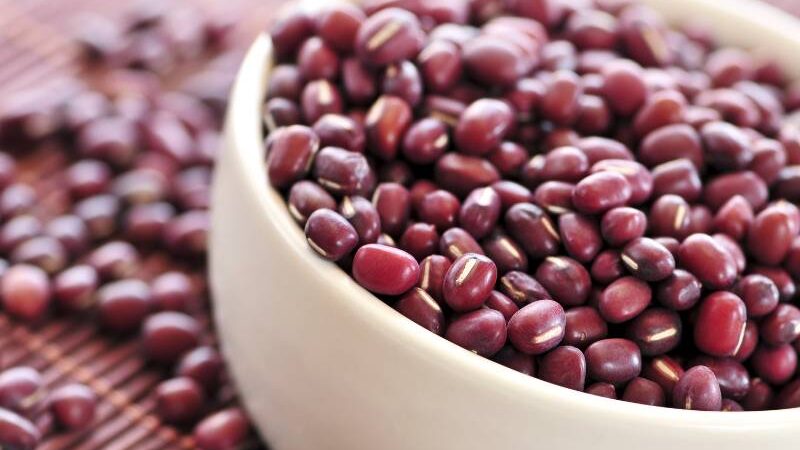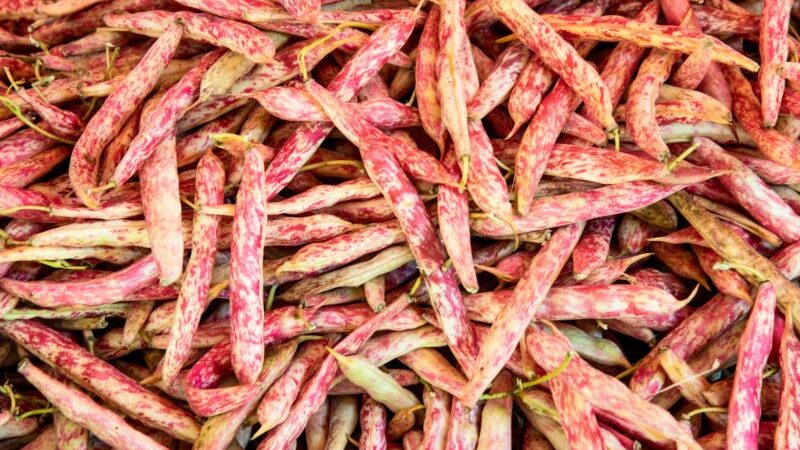Native from Asia, adzuki beans are a very popular type of red bean widely eaten around countries like China, Japan and Korea. Growing adzuki beans is a good idea for gardeners who want to have a multi-purpose legume, after all, this bean can be harvested as a snap bean or as a dry bean and used in both salty and sweet dishes!
As with kidney beans and red beans, adzuki beans take a long period of time from seed to harvest, which is about 90-120 days depending on the cultivar. Due to this, they need to be properly planted, specially in areas with short warm seasons.
In the next article, we’ll see step by step some efficient ways to grow adzuki beans and I’ll share some tips on how to care for them.

How to Grow Adzuki Beans
Start by scarifying your seeds with some sandpaper of by wounding them with a knife. After this, plant them 1-1.5 inches deep in a spot with full sun along with a rich nutrient soil when the temperature is at least 60° F in the soil and 65-85° F in air.
Space the plants 2-3 inches apart and 1-3 feet between rows depending on the variety you are planting. Water until the soil is moist but not waterlogged and wait 1-2 weeks for the seeds to sprout.
If planted in garden beds, the seeds may be robbed by rabbits, rodents, or other animals, placing hardware cloth or chicken wire until your seeds will help you with this problem.
Growing Adzuki Beans In Short Season Areas.

To start growing adzuki beans, put your seeds through a scarification process. According to this study done by the Institute For Agricultural Technology of Maluku Providence, the most efficient scarifying method for long beans was to place the seeds in the oven at 55° F for 10 minutes. Despite this, scratching in sandpaper and wounding the seeds also proved to be effective.
I honestly prefer the sandpaper method and the wounding one as they are safer to accomplish. But if you want to scarify the seeds in a bulk without too much effort, the heating method is a good choice.
After scarifying your seeds, you want to plant your seeds in seedling trays filled with some potting mix, do this by making a 1-1.5 inch deep hole and placing 1-2 seeds (to maximize the chances of sowing). Cover with soil, water them and put them under some grown lights for a couple of weeks.
All of this process should be done 2-3 weeks before your last frost date. The seeds should sprout in 1-2 weeks and they will be ready to be transplanted when they reach their first set of true leaves.
Transplanting Adzuki Beans.
Beans in general are not a good plant to be transplanted, as they have sensitive and shallow roots that can easily suffer from transplant shock. That’s why we want to make sure we transplant the seedlings very carefully.
It’s also a good idea to use some inoculant powder to help with the root establishment after transplanting, to increase the chances of having our beans settled in their new area.
Can you Grow Adzuki Beans in Pots?

As adzuki beans are small, shallow rooted plants, they are good candidates to be grown in pots. This is specially true if they are planned to be consumed as snap beans. Despite this, due to the low individual production of bean plants, it’s not really optimal to grow them in pots.
If you still decide to grow them in pots, here are some tips on how to do it.
To sow adzuki beans in containers, plant them 1 inch deep into the soil. You can use potting mix for the soil or just blend one for yourself by mixing 1/3 of compost, 1/3 of peat moss or coco coir and 1/3 of perlite or vermiculite. Just try to make sure your soil is in that Ph range of 6-7 that beans thrive for!
The pot should be about 12 inches in diameter and 10 inches deep. Here I’ll leave a link to amazon to acquire 5 gallon pots that work well to plant bush and vining beans.
Remember to have some draining holes ready in any pot that you use. As beans do not like getting “wet feet” as this could lead to root rot.
Soil
When growing adzuki beans, the soil should be in a temperature of 60° F or above and have a Ph between 6-7. They thrive in any soil but are better planted in clay or loamy soils and it’s important to mix the soil with compost to ensure they are growing in a rich nutrient soil
For the best results, adzuki beans should be located in a spot with full sun.
Beans are a great crop to grow as the bacteria living in their roots will take nitrogen from the air and provide it to be plant, so it’s not necessary to apply fertilizer for them to grow. If we were to apply a fertilizer with nitrogen this would only induce foliage growth which would decrease the amount of blooms in the plant.
If you want them to grow faster, give them a side dress of compost mid-season or you can also apply a kelp extract solution.
Mulching
Applying mulch is very important for our adzuki beans as it will help them conserve it’s moisture and temperature. This is specially true if you live in an area that can have very warm days.
Before applying mulch though, make sure remove all the weeds from your garden bed, preferably by hand as the tools could go too deep into the soil and damage the shallow roots of the plant.
Diseases
Some diseases that can affect adzuki beans are root rot and mildew. Both of these can happen by very humid and warm temperatures, of by bad techniques when watering the plant.
To prevent this, acquire disease resistant cultivars and practice better watering techniques, such as watering the soil and not the foliage and leaves and watering in the morning. If the situation doesn’t look good, try applying a fungicide.
Harvesting
If the beans want to be harvested as snap beans, they can be collected just after 2-3 months after planting. In the other hand, if you want to harvest them as dry beans, then it may take 90-120 days or even more depending on the variety.
If harvested as dry beans, we want to harvest when the pods are in a light brown color and the seeds rattle a bit.
There are a couple ways to harvest dry beans. The pods can be picked up by hand when they are ready and then opened to release the seeds, or you can throw the pods into a bag and throw it against the floor, most of the seeds will get out of the pods which saves a lot of time.
Despite this, in the second method some parts of the pods will be together with the beans so you will need to winnow your beans to “clean them”.

Using Adzuki Beans
Adzuki beans can be used in a variety of ways. They are commonly used in the Asian cuisine as a red bean paste, which is a good flavor to add in different pastries. This paste is made with dry beans.
In Japan they are also eaten with rice (which is also my favorite way to eat beans in general). They may also be boiled and drink in some kind of teas.
And this is it for the article on how to grow adzuki beans! I hope this was useful for you and I wish it gave helped you in any way. Wishing you a good season gardener!



